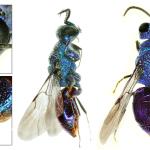Previously known as Omalus truncatus. Identification keys and general biology are given in Spooner (1954), Morgan (1984), Falk (1991) and Kunz (1994).
Very rare, with only five records traced, all from southern England: Dorset (nineteenth century), Berkshire (1901), Essex (1906), Surrey (1910), Herefordshire (1983).
Overseas, the wasp occurs in Norway, Sweden, Denmark, The Netherlands, Belgium, France, Spain, Germany, Italy, Poland, Hungary), western Asia and north Africa.
See Morgan (1984) for identification.
The posterior of the third gastral tergite is vertically truncated above the central notch (bottom right and lateral view in the montage).
The head, thorax, and anterior gaster are violet; posterior gaster is blue green with viloet.
Probably associated with habitats containing dead wood and hollow stems in sunny warm situations.
The few records available are from June and July.
No British information found; overseas, swept from Apiaceae.
No specific information found.


